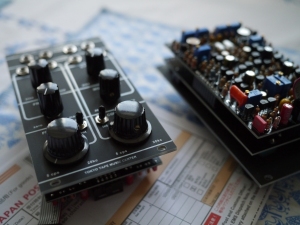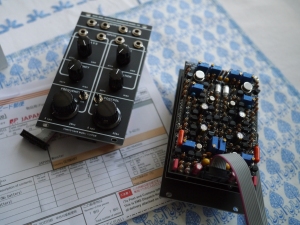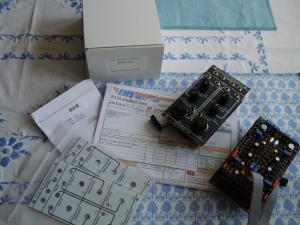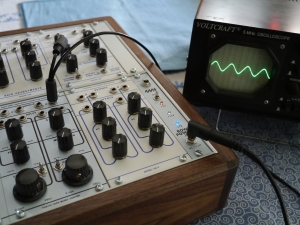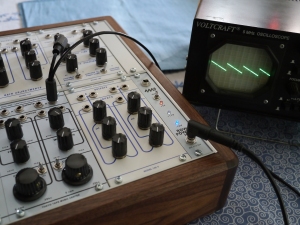The legendary and ultra rare Buchla 100 system seems to be unreachable for a long time. During the last decade a vivid DIY scene started to clone the old modules, e.g. La 67 or Peake.
Nowadays, manufacturer like Catalyst Audio, Tokyo Tape Music Center or Low-Gain Electronics started to sell clones for Eurorack or in 4U format. Buchla announced recently (Sept 2019) an official re-release of the 100 series under the brand Red Panel, which are based on the Catalyst Audio Eurorack adaption, as well as official DIY kits of the original 4U version.
I decided to start my build of a small Buchla 100 clone in the beginning of 2018, where Catalyst Audio offered Eurorack compatible modules. Due to the lack of time (and probably skills) the DIY was not a realistic option for me. My main interest was driven by the inimitable sound of the oscillators and also by the (today’s limited) system design itself. In the following I want to share my first impressions and sounds of a my recently finished mini Buchla 100 clone.
Some initial thoughts
The modular should be based solely on the old module designs of the original Buchla 100 series with its limitations and idiosyncrasies in sound and operation. I prefer a compact system with a good focus on the characteristics, but it should be more complex than a simple monophonic voice. My collection should be limited on the core functions of a synth voice (VCO, VCA, MIXER, ENV), i.e. there will be no space for sequencer or more sophisticated control options, but it could be driven easily by external CV/gate.

Transistor driven circuit design
Another important aspect for my choice was a fully transistor based build with through-hole parts. In my opinion SMD production doesn’t feel right to me for a close re-creation of an ‘ancient’ modular synth. The 4U clones were excluded to keep it compatible to my given infrastructure and also to cut the expenses. The final build ended up as a small two voice system, which is composed of 8 modules.
Module selection:
- 2x Model 158, Voltage controlled oscillator (Tokyo Tape Music Center)
- 2x Model 156, Voltage processor (Catalyst Audio)
- 2x Model 180, Envelope generator (Catalyst Audio)
- 1x Model 110, Voltage controlled amplifier (Catalyst Audio)
- 1x Model 106, Audio mixer (Catalyst Audio)
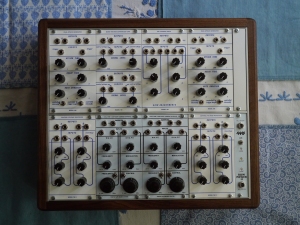
Layout of the module selection
The modules by Catalyst Audio have a really great look and feel with powder coated panels. I also appreciate that the original Model 110 with a dual VCA was doubled to a quad VCA. Unfortunately, I missed the first batch of the Model 158, which were manufactured with through-hole parts. Thus, I switched to Tokyo Tape Music Center for the oscillators Model 158A and I am very happy with my decision. The build quality is very high and the circuit is based on NOS transistors, which sound very clean, but easily goes raw and wild if required.
Following functions are covered (in a beautiful symmetrical way):
- 4x VCOs
- 4x VCAs
- 4x Envelopes
- 4x Crossfader for mixing envelopes and provide offsets for VCO or VCA
- 2x Three channel mixer for stereophonic mixing (or six channel to mono)
Some specific characteristics
It is (probably) difficult to play the system tonally (I didn’t try it yet). In contrast to Red Panel the TTMC oscillators are calibrated to 1.2V/Oct, i.e. a pitch CV of a common 1V/Oct source requires an amplification and re-calibration. Furthermore, an external CV for the VCO requires an offset voltage. The offset and pitch CV is mixed with crossfading on the Model 156 (vintage version with transistors), which results in an attenuation of the pitch CV. This is the reason why Red Panel also offers a modern op-amp based Model 156M with a different routing.
But the vintage version of Model 156 includes a clever feature: the second unit offers an inverted CV input which is basically a DC offset minus the input CV. This allows a simple option for panning and voltage controlled crossfadings (remember that CV is always positive). Another nice trick is that the Model 180 envelope does not retrigger while running, i.e. it can be used two create n:m ratio of clock divisions from a single trigger source.
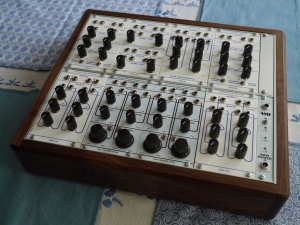
A beautiful wooden cabinet supports the vintage look&feel.
In the end, I was really surprised how easy and how nice one can patch quite sophisticated stereo effects with the combination of transistor inverter, dual audio outputs and the two mixer sections. Many analogue vintage synth do not support stereo outs or at least rather rudimentary stereo processing with for example a chorus. In the Buchla world stereo patching feels very natural and is quite comfortable. The modules are much deeper and sophisticated than they seem to be at first glance. And it doesn’t surprise that Don Buchla also experimented with quadraphonic effect boxes quite early…
Talking about signal levels
The modules by Catalyst Audio are buffered by an op-amp circuit and are capable to run on Buchla signal levels. The level type can be switched by simply changing a jumper on the back of the PCB. As far as I know, the main difference is the lower audio level on Buchla systems with +0db (approx 1Vpp) compared to +12dB in Eurorack (approx. 4Vpp). In the Buchla world audio and CV are separated by different jack types (tiny-jax for bipolar audio and banana jacks for unipolar CV). The eurofied modules only provide a single jack type (common mini-jacks), which makes it (at least level-wise) less useful to separate between audio and CV. There are still some caveats regarding AC/DC processing, e.g. the Model 110 VCA is AC coupled and does not support DC voltages at the audio input or the voltage processor Model 156 is restricted to positive voltages etc. At the end of the day, I decided to run the whole system in the Eurorack compatible mode because of the homogeneous jack types and the hot oscillator outputs.
Grandma’s synthesizer
Working with the system is more challenging and different compared to conventional Eurorack. There is no visual feedback by LEDs, missing offsets and parameters, which lack an automation via CV. It somehow feels like a historical instrument and I got an impression how laborious the early compositions from the 60ties were. The puristic features and the raw sound are though absolutely inspiring to me. All in all, it is rewarding and fun to work with, but I would not recommend it to a modular beginner.
The Buchla 100 test ride
I want to finish with some recordings of my first attempts. The demos were simply recorded without external CV/gate, i.e. a dual envelope was directly triggered by one of the four oscillators. The stereo out was processed by a Boss DC-2w, Strymon Flint and Redpanda Particle V2. Have fun!
Acknowledgments
First, I would like to thank Buchla for building such original instruments and bringing them back again. I am also very grateful to the community and all the people who were involved in the reviving the Buchla 100. My special thanks go to Dave from Catalyst Audio, Kurosaki from Tokyo Tape Music Center and Carl from Sawandsolder, who crafted this beautiful wooden cabinet.
